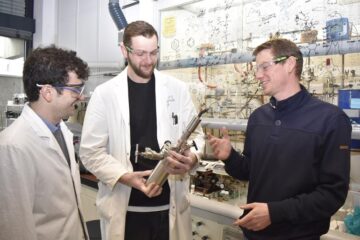Plankton cool the southern hemisphere

Dutch research has shown that marine plankton have the greatest effect on the climate in the southern hemisphere, even though the majority of plankton are found in oceans in the northern hemisphere.
Mtinkheni Gondwe used satellite observations to follow the distribution of phytoplankton in the oceans. Although the majority of plankton are found between the middle and high latitudes in the northern hemisphere, the effect of these on the climate is greatest in the southern hemisphere.
Plankton can influence the climate by producing the gas dimethyl sulphide (DMS). This gas is a source of small sulphur particles in the atmosphere, which act as condensation nuclei for the water vapour. The miniscule water drops formed in the air as a result of this, reflect the sunlight back before it reaches the Earth, causing the Earth to cool.
There are various reasons why plankton exert a greater influence on the climate in the southern hemisphere than in the northern hemisphere. For example, the plankton species in the southern hemisphere produce more DMS than their northern counterparts. Also in the southern hemisphere there is a higher DMS flux from the sea to the atmosphere and the sea surface area is greater. Finally, the atmosphere has a lower oxidation capacity in the southern hemisphere than in the northern hemisphere, which means that less DMS is broken down in the atmosphere. In the more industrialised northern atmosphere, there is a far greater emission of radical precursors which increase this oxidation capacity.
However, Gondwe concludes that the production of DMS by plankton only has a small effect on the Earth’s temperature. Other compounds, such as carbon dioxide and CFCs have a far greater effect on the Earth’s climate. The effects of the DMS production by plankton are particularly noticeable at a regional level.
The research was funded by the Netherlands Organisation for Scientific Research.
Media Contact
More Information:
http://www.nwo.nlAll latest news from the category: Ecology, The Environment and Conservation
This complex theme deals primarily with interactions between organisms and the environmental factors that impact them, but to a greater extent between individual inanimate environmental factors.
innovations-report offers informative reports and articles on topics such as climate protection, landscape conservation, ecological systems, wildlife and nature parks and ecosystem efficiency and balance.
Newest articles

Lower dose of mpox vaccine is safe
… and generates six-week antibody response equivalent to standard regimen. Study highlights need for defined markers of mpox immunity to inform public health use. A dose-sparing intradermal mpox vaccination regimen…

Efficient, sustainable and cost-effective hybrid energy storage system for modern power grids
EU project HyFlow: Over three years of research, the consortium of the EU project HyFlow has successfully developed a highly efficient, sustainable, and cost-effective hybrid energy storage system (HESS) that…

Safer alternative for an explosive reaction
The chemical industry has been using a reaction with explosive chemicals for over 100 years – now Mülheim scientists have discovered a safer alternative. The Ritter Group of the Max…





















